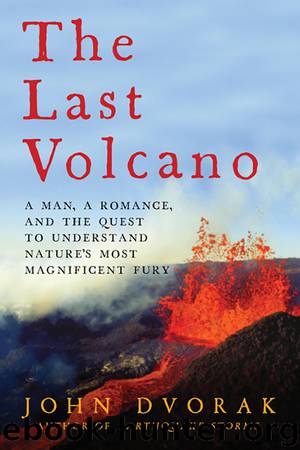The Last Volcano by John Dvorak

Author:John Dvorak
Language: eng
Format: epub
Publisher: Pegasus
The role of gases in volcanic eruptions was self-evident to anyone who has seen an eruption. Lava froths furiously and fountains during eruptions, causing huge plumes of gas to rise up and fill the sky over volcanoes. Lacroix had concluded that these gases had been dissolved within molten rock, then released. But what types of gases were involved?
Those with a sulfur component were an obvious choice. Sulfur is the stench common in volcanic regions, an odor that resembles that of rotting eggs. In the same region, if one looks into hollows or caves, one is apt to find scatterings of dead insects or the occasional dead mouse or small bird or, in extreme cases when conditions are right, the carcasses of large animals, as Jaggar had seen at Death Gulch at Yellowstone. Such deaths were caused by the presence of carbon dioxide that, because it is heavier than air, accumulates in hollows and caves. Many nights I have sat close to where molten lava is gushing out of the ground and have been intrigued by, among other things, the flickering of thousands of tiny pale blue flames. The pale blue flames indicate the burning of hydrogen gas. But which of these is the major component of the gases emitted in volcanic eruption?
In the 18th century, when the first systematic observations of volcanoes were being made, people rushed to the conclusion that different volcanoes emitted different types of gases. Etna was an emitter of sulfur dioxide. The perennial plume that hung over Vesuvius for most of the 18th and 19th centuries was thought to contain primarily hydrogen sulfide. The deaths of grazing animals in places such as the Dieng Plateau in Indonesia, an area surrounded by volcanoes, was thought to be caused by the sudden release of carbon dioxide.
In the 1860s, during a tour of Italian volcanoes, French chemist Ferdinand Fouqué tried to settle the question. Included in his equipment was a large watertight leather bag that he would hold up and collect as much gas from the edge of a volcanic crater as possible. He then examined the contents of the bag. Invariably, small beads of water had formed. And dissolved within the water were a variety of acids: hydrochloric acid, sulphuric acid and carbonic acid. From this simple experiment Fouqué concluded that different volcanoes probably did emit different gases, primarily those that contained hydrogen, sulfur and carbon in varying combinations, but all of the volcanoes did have one gas in common: They all emitted water vapor.
That is where the measurement of volcanic gases stood for nearly forty years. Then, in 1902, Swiss chemist Albert Brun was inspired by the eruption of Mount Pelée to study volcanoes. He had an advantage over others, like Jaggar and Perret, who had also been inspired by that eruption: Brun had a personal fortune to finance his work and his travels.
He began with the volcanoes of southern Italy—Vesuvius, Etna and Stromboli. He would walk into a field of steam and smoke and insert one end of a long glass tube into a hot crack.
Download
This site does not store any files on its server. We only index and link to content provided by other sites. Please contact the content providers to delete copyright contents if any and email us, we'll remove relevant links or contents immediately.
| Geomorphology | Historical |
| Limnology | Physical |
| Plate Tectonics | Sedimentary |
| Specific Locations | Structural |
| Volcanology |
Man-made Catastrophes and Risk Information Concealment by Dmitry Chernov & Didier Sornette(4735)
The Revenge of Geography: What the Map Tells Us About Coming Conflicts and the Battle Against Fate by Kaplan Robert D(3597)
Zero Waste Home by Bea Johnson(3288)
COSMOS by Carl Sagan(2950)
In a Sunburned Country by Bill Bryson(2946)
Good by S. Walden(2914)
The Fate of Rome: Climate, Disease, and the End of an Empire (The Princeton History of the Ancient World) by Kyle Harper(2436)
Camino Island by John Grisham(2383)
A Wilder Time by William E. Glassley(2362)
Organic Mushroom Farming and Mycoremediation by Tradd Cotter(2307)
Human Dynamics Research in Smart and Connected Communities by Shih-Lung Shaw & Daniel Sui(2177)
The Ogre by Doug Scott(2114)
Energy Myths and Realities by Vaclav Smil(2060)
The Traveler's Gift by Andy Andrews(2011)
Inside the Middle East by Avi Melamed(1939)
Birds of New Guinea by Pratt Thane K.; Beehler Bruce M.; Anderton John C(1906)
Ultimate Navigation Manual by Lyle Brotherton(1767)
A History of Warfare by John Keegan(1713)
And the Band Played On by Randy Shilts(1615)
